Study of Metakaolinite Geopolymeric Mortar with Plastic Waste Replacing the Sand: Effects on the Mechanical Properties, Microstructure, and Efflorescence
Abstract
1. Introduction
2. Materials and Methods
2.1. Raw Materials and Naming of the Samples
2.2. Processing and Characterization of Kaolin
2.3. Characterization of Metakaolinite and Aggregates
2.4. Manufacture of the Mortars
2.5. Characterization of Mortars
2.5.1. Mechanical Strength Test
2.5.2. Porosity and Water Absorption Test
- Msat is the mass of saturated material;
- Ms is the mass of the oven-dried material;
- Msat.i is the mass of the immersed saturated material, and M is the mass of the material after curing.
- All masses were measured in grams.
2.5.3. X-ray Diffractometry and Microstructure
2.5.4. Efflorescence Test
3. Results
3.1. Thermogravimetry of the Kaolin
3.2. X-ray Diffractometry of Kaolin and Metakaolinite
3.3. Chemical Composition of Metakaolinite Using XRF
3.4. Morphology of the Particles of the Raw Materials
3.5. Laser Granulometry of the Raw Materials
3.6. Compressive Strength Test
3.7. Absorption and Porosity Test
3.8. Phase Identification in the GP-S and GP-C Mortars Using XRD
3.9. Microstructure of the Mortars
3.10. Efflorescence Test
4. Conclusions
Supplementary Materials
Author Contributions
Funding
Institutional Review Board Statement
Informed Consent Statement
Data Availability Statement
Acknowledgments
Conflicts of Interest
References
- Bai, C.; Colombo, P. Processing, properties and applications of highly porous geopolymers: A review. Ceram. Int. 2018, 44, 16103–16118. [Google Scholar] [CrossRef]
- Bernal, S.A.; de Gutierrez, R.M.; Rodrigues, E.D. Materiales de activación alcalina: Ementando un futuro sostenible. Ing. Compet. 2013, 15, 211. [Google Scholar] [CrossRef]
- Davidovits, J. Geopolymer cement a review. Inst. Géopolimère 2013, 21, 1–11, St. Quentin, France. Available online: http://www.geopolymer.org (accessed on 13 March 2022).
- McLellan, B.C.; Williams, R.P.; Lay, J.; Van Riessen, A.; Corder, G.D. Costs and carbon emissions for geopolymer pastes in comparison to ordinary Portland cement. J. Clean. Prod. 2011, 19, 1080–1090. [Google Scholar] [CrossRef]
- UN Environment; Scrivener, K.L.; John, V.M.; Gartner, E.M. Eco-efficient cements: Potential economically viable solutions for a low-CO2 cement-based materials industry. Cem. Concr. Res. 2018, 114, 2–26. [Google Scholar] [CrossRef]
- Kunthawatwong, R.; Sylisomchanh, L.; Pangdaeng, S.; Wongsa, A.; Sata, V.; Sukontasukkul, P.; Chindaprasirt, P. Recycled Non-Biodegradable polyethylene terephthalate waste as fine aggregate in fly ash geopolymer and cement mortars. Const. Build. Mater. 2022, 238, 127084. [Google Scholar] [CrossRef]
- Malhotra, V.M. Introduction: Sustainable development and concrete technology. ACI Concr. Int. 2002, 24, 7–22. [Google Scholar] [CrossRef][Green Version]
- Roy, D.M. Alkali-activated cements: Opportunities and challenges. Cem. Concr. Res. 1999, 29, 249–254. [Google Scholar] [CrossRef]
- Nergis, D.D.B.; Vizureanu, P.; Sandu, A.V.; Nergis, D.P.B.; Bejinariu, C. XRD and TG-DTA Study of New Phosphate-Based Geopolymers with Coal Ash or Metakaolin as Aluminosilicate Source and Mine Tailings Addition. Materials 2022, 15, 202. [Google Scholar] [CrossRef]
- Geyer, R.; Jambeck, J.R.; Law, K.L. Production, use, and fate of all plastics ever made. Sci. Adv. 2017, 3, 1700782. [Google Scholar] [CrossRef]
- Balwada, J.; Samaiya, S.; Mishra, R.P. Packaging plastic waste management for a circular economy and identifying a better waste collection system using analytical hierarchy process (ahp). Procedia CIRP 2021, 98, 270–275. [Google Scholar] [CrossRef]
- Gertsakis, J.; Lewis, H. A discussion paper on the waste management hierarchy and its relationship to sustainability. Sustainability and the Waste Management Hierarchy. Retrieved Jan. 2003, 30, 2008. Available online: http://www.helenlewisresearch.com.au/wp-content/uploads/2014/05/TZW_-_Sustainability_and_the_Waste_Hierarchy_2003.pdf (accessed on 28 August 2021).
- Hariadi, D.; Saleh, S.M.; Yamin, R.A.; Aprilia, S. Utilization of ‘ plastic waste on the quality of pyrolysis oil as na asphalt solvente alternative. Ther. Sci. Eng. Prog. 2021, 23, 100872. [Google Scholar] [CrossRef]
- Bhogayata, A.C.; Arora, N.K. Utilization of metalized plastic waste of food packaging articles in geopolymer concrete. J. Mater. Cycles Waste Manag. 2019, 21, 1014–1026. [Google Scholar] [CrossRef]
- Binici, H. Effect of aggregate type on mortars without cement. Eur. J. Eng. Technol. 2013, 1, 1–6. Available online: https://www.idpublications.org/wp-content/uploads/2013/08/effect-of-aggregate-type-on-mortars-without-cement.pdf (accessed on 15 December 2021).
- Thorneycroft, J.; Orr, J.; Savoikar, P.; Ball, R.J. Performance of structural concrete with recycled plastic waste as a partial replacement for sand. Constr. Build. Mater. 2018, 161, 63–69. [Google Scholar] [CrossRef]
- Rubio-de Hita, P.; Péres-Gálvez, F.; Morales-Conde, M.J.; Reid, A.; Pedreño-Rojas, M.A. Reuse of plastic waste of mixed polypropylene as aggregate in mortars for the manufacture of pieces for restoring jack arch floors with timber beams. J. Clean. Prod. 2018, 198, 1515–1525. [Google Scholar] [CrossRef]
- Bahoria, B.V.; Parbat, D.K.; Nagarnaik, P.B. XRD analysis of natural sand, quarry dust, waste plastic (ldpe) to be used as a fine aggregate in concrete. Mater. Today Proc. 2018, 5, 1432–1438. [Google Scholar] [CrossRef]
- Nuaklong, P.; Sata, V.; Chindaprasirt, P. Influence of recycled aggregate on fly ash geopolymer concrete properties. J. Clean. Prod. 2018, 112, 2300–2307. [Google Scholar] [CrossRef]
- Jassim, A.K. Recycling of Polyethylene Waste to Produce Plastic Cement. Procedia Manuf. 2017, 8, 635–642. [Google Scholar] [CrossRef]
- Yao, X.; Yang, T.; Zhang, Z. Compressive strength development and shrinkage of alkali-activated fly ash–slag blends associated with efflorescence. Mater. Struct. 2016, 49, 2907–2918. [Google Scholar] [CrossRef]
- Kang, S.P.; Kwon, S.J. Effects of red mud and Alkali-Activated Slag Cement on efflorescence in Cement mortar. Constr. Build. Mater. 2017, 133, 459–467. [Google Scholar] [CrossRef]
- Xue, X.; Liu, Y.L.; Dai, J.G.; Poon, C.S.; Zhang, W.D.; Zhnag, P. Inhibiting efflorescence formation on fly-ash geopolymer via silane surface modification. Cem. Concr. Res. 2018, 94, 43–52. [Google Scholar] [CrossRef]
- Zhang, Z.; Provis, J.L.; Reid, A.; Wang, H. Flay ash-based: The relationship between composition, pore estructure and efflorescence. Cem. Concr. Res. 2014, 64, 30–41. [Google Scholar] [CrossRef]
- Davidovits, J. Mineral Polymers and Methods of Making Them. U.S. Patent 4,349,386, 1982. Available online: https://patents.google.com/patent/US4349386A/en (accessed on 29 August 2022).
- Lahoti, M.; Narang, P.; Tan, K.H.; Yang, E.H. Mix design factors and strenght prediction of metakaolin-based geopolymer. Ceram. Inter. 2017, 43, 11433–11441. [Google Scholar] [CrossRef]
- Longhi, M.A.; Rodriguez, E.D.; Walkley, B.; Zhang, Z.; Kirchheim, A.P. Metakaolin-based geopolymers: Relation beteween formulation, physicochemical properties and efflorescence formation. Compos. Part B 2020, 182, 107671. [Google Scholar] [CrossRef]
- Associação Brasileira de Normas Técnicas (ABNT) 7215; Determinação de Resistência à Compressão de Corpos Cilíndricos. Associação Brasileira de Normas Técnicas (ABNT): Rio de Janeiro, Brazil, 2019.
- Associação Brasileira de Normas Técnicas (ABNT) 9778; Argamassa e Concreto Endurecidos. Associação Brasileira de Normas Técnicas (ABNT): Rio de Janeiro, Brazil, 2005.
- Izadifar, M.; Thissen, P.; Steude, A.; Kleeberg, R.; Kaufhold, S.; Kaltenbach, J.; Schuhmann, R.; Dehn, F.; Emmerich, K. Comprehensive examination of dehydroxylation of kaolinite, disordered kaolinite, and dickite: Experimental studies and density functional theory. Clays Clay Miner. 2020, 68, 319–333. [Google Scholar] [CrossRef]
- Cheng, H.; Liu, Q.; Yang, J.; Frost, R.L. Thermogravimetric analysis of selected coal-bearing strata kaolinite. Thermochim. Acta 2010, 507–508, 84–90. [Google Scholar] [CrossRef]
- Liu, d.; Zhang, Y.; Zhou, A.; Nnachi, E.N.; Huo, S.; Zhang, Q. The Kaolinite Crystallinity and Influence Factors of Coal-Measure Kaolinite Rock from Datong Coalfield, China. Minerals 2022, 12, 54. [Google Scholar] [CrossRef]
- Daou, I.; Lecomte-Nana, G.L.; Tessier-Doyen, N.; Peyratout, C.; Gonon, M.F.; Guinebretiere, R. Probing the Dehydroxylation of Kaolinite and Halloysite by In Situ High Temperature X-ray Diffraction. Minerals 2020, 10, 480. [Google Scholar] [CrossRef]
- Singh, B.; Ishwarya, G.; Gupta, M.; Bhattacharyya, S.K. Geopolymer concrete: A review of some recent developments. Constr. Build. Mater. 2015, 85, 78–90. [Google Scholar] [CrossRef]
- Faqir, N.M.; Shawabkeh, R.; Al-Harthi, M.; Wahhab, H.A. Fabrication of Geopolymers from Untreated Kaolin Clay for Construction Purposes. Geotech. Geol. Eng. 2019, 37, 129. [Google Scholar] [CrossRef]
- Tan, D.; Yuan, P.; Annabi-Bergaya, F.; Liu, D.; He, H. Methoxy-modified kaolinite as a novel carrier for high-capacity loading and controlled-release of the herbicide amitrole. Sci. Rep. 2015, 5, 8870. [Google Scholar] [CrossRef]
- Ptáček, P.; František, S.; Opravil, T.; Havlica, J.; Brandštetr, J. The kinetic analysis of the thermal decomposition of kaolinite by DTG technique. Powder Technol. 2011, 208, 20–25. [Google Scholar] [CrossRef]
- Oluseyi, A.K.; Olanrewaju, A.; Pal, M.; Das, S.K. Evaluation of Nigerian Source of Kaolin as a Raw Material for Mullite Synthesis. Orient. J. Chem. 2016, 32, 1571–1582. [Google Scholar] [CrossRef]
- Alzaza, A.; Mastali, M.; Kinnunen, P.; Korat, L.; Abdollahnejad, Z.; Ducman, V.; Illikainen, M. Production of lightweight alkali activated mortars using mineral wools. Materials 2019, 12, 1695. [Google Scholar] [CrossRef]
- Granizo, M.L.; Blanco-Varela, M.T.; Palomo, A. Influence of the starting kaolin on alkali-actived materials based on metakaolin. Study of the reaction parameters by isothermal conduction calorimetry. J. Mater. Sci. 2002, 35, 6309–6315. [Google Scholar] [CrossRef]
- Associação brasileira de Normas Técnicas (ABNT) 6502; Rochas e Solos—Terminologia. Associação Brasileira de Normas Técnicas (ABNT): Rio de Janeiro, Brazil, 1995.
- Associação Brasileira de Normas Técnicas (ABNT) 7211; Agregados para concreto. Associação Brasileira de Normas Técnicas (ABNT): Rio de Janeiro, Brazil, 2019.
- Ahmadi, H. Metakaolin-red mud/carbon nanotubes geopolymer nanocomposite: Mechanical properties and structural studies. Mater. Res. Express. 2022, 9, 025011. [Google Scholar] [CrossRef]
- Meesala, C.R.; Verma, N.K.; Kumar, S. Critical review on fly-ash based geopolymer concrete. Struct. Concr. 2019, 21, 1013–1028. [Google Scholar] [CrossRef]
- Azevedo, A.D.S.; Strecker, K.; Lombardi, C.T. Metakaolin and red ceramic based geopolymers production. Cerâmica 2018, 64, 388–396. [Google Scholar] [CrossRef]
- Bature, A.S.; Khorami, M.; Ganjian, E.; Tyrer, M. Influence of alkali activator type and proportion on strength performance of calcined clay geopolymer mortar. Constr. Build. Mater. 2021, 267, 120446. [Google Scholar] [CrossRef]
- Wan, Q.; Rao, F.; Song, S.; García, R.E.; Estrella, R.M.; Patiño, C.L.; Zhang, Y. Geopolymerization reaction, microstructure and simulation of metakaolin-based geopolymers at extended Si/Al ratios. Cem. Concr. Compos. 2017, 79, 45–52. [Google Scholar] [CrossRef]
- Rozeck, P.; Król, M.; Mozgawa, W. Geopolymer-zeolite composites: A review. J. Clean. Prod. 2019, 230, 557–579. [Google Scholar] [CrossRef]
- Istuque, D.B.; Reig, L.; Moraes, J.C.B.; Akasaki, J.L.; Borrachero, M.V.; Soriano, L.J.; Tashima, M.M. Behaviour of metakaolin-based geopolymers incorporating sewage sludge ash (ssa). Mater. Lett. 2016, 180, 192–195. [Google Scholar] [CrossRef]
- Davidovits, J. Geopolymers inorganic polymeric new materials. J. Therm. Anal. Calorim. 1991, 37, 1633–1656. [Google Scholar] [CrossRef]
- Weng, L.; Sagoe-Crentsil, K.; Brown, T.; Song, S. Effects of aluminates on the formation of geopolymers. Mater. Sci. Eng. B 2005, 117, 163–168. [Google Scholar] [CrossRef]
- Tan, J.; Cizer, O.; Vandevyvere, B.; De Vlieger, J.; Dan, H.; Li, J. Efflorescence mitigation in construction and demolition waste (CDW) based geopolymer. J. Build. Eng. 2022, 58, 105001. [Google Scholar] [CrossRef]
- Pacheco-Torgal, F.; Moura, D.; Ding, Y.; Jalali, S. Composition, Strenght and workability-activated metakaolin based mortars. Const. Build. Mater. 2011, 25, 3732–3745. [Google Scholar] [CrossRef]
- Simão, L.; Fernades, E.; Hotza, D.; Ribeiro, M.J.; Montedo, O.R.K.; Raupp-Pereira, F. Controlling efflorescence in geopolymers: A new approach. Case Stud. Constr. Mater. 2021, 15, e00740. [Google Scholar] [CrossRef]

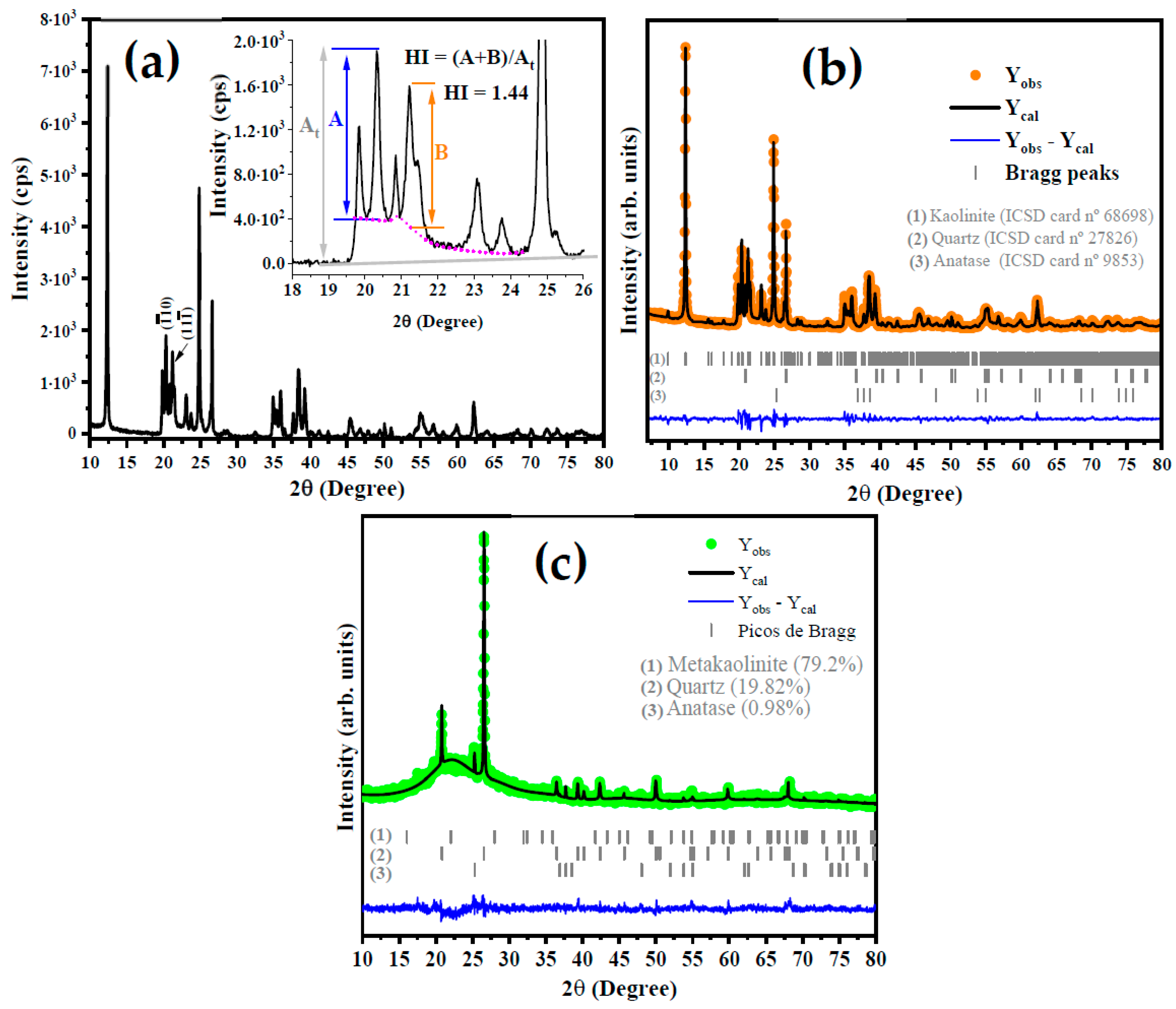

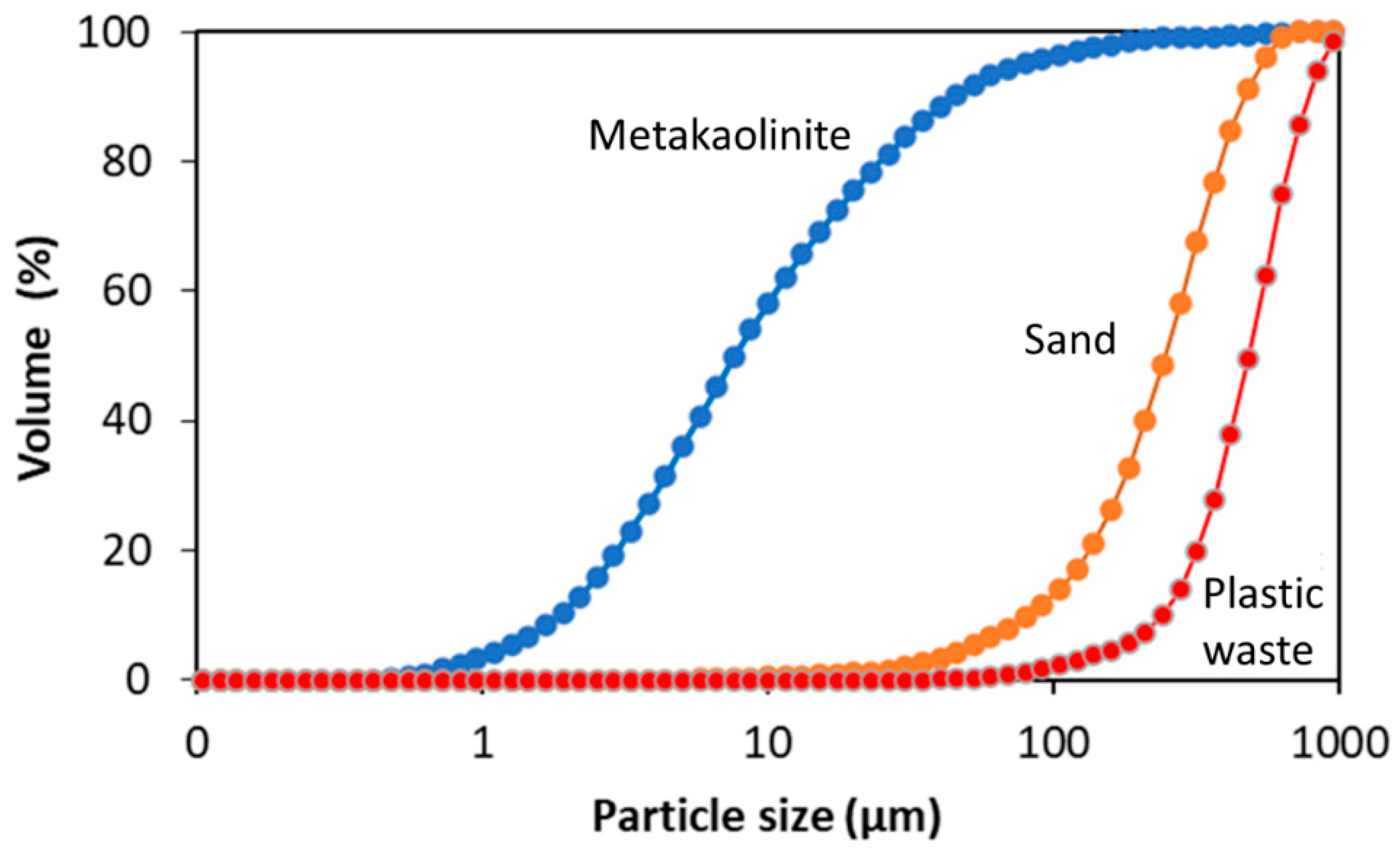
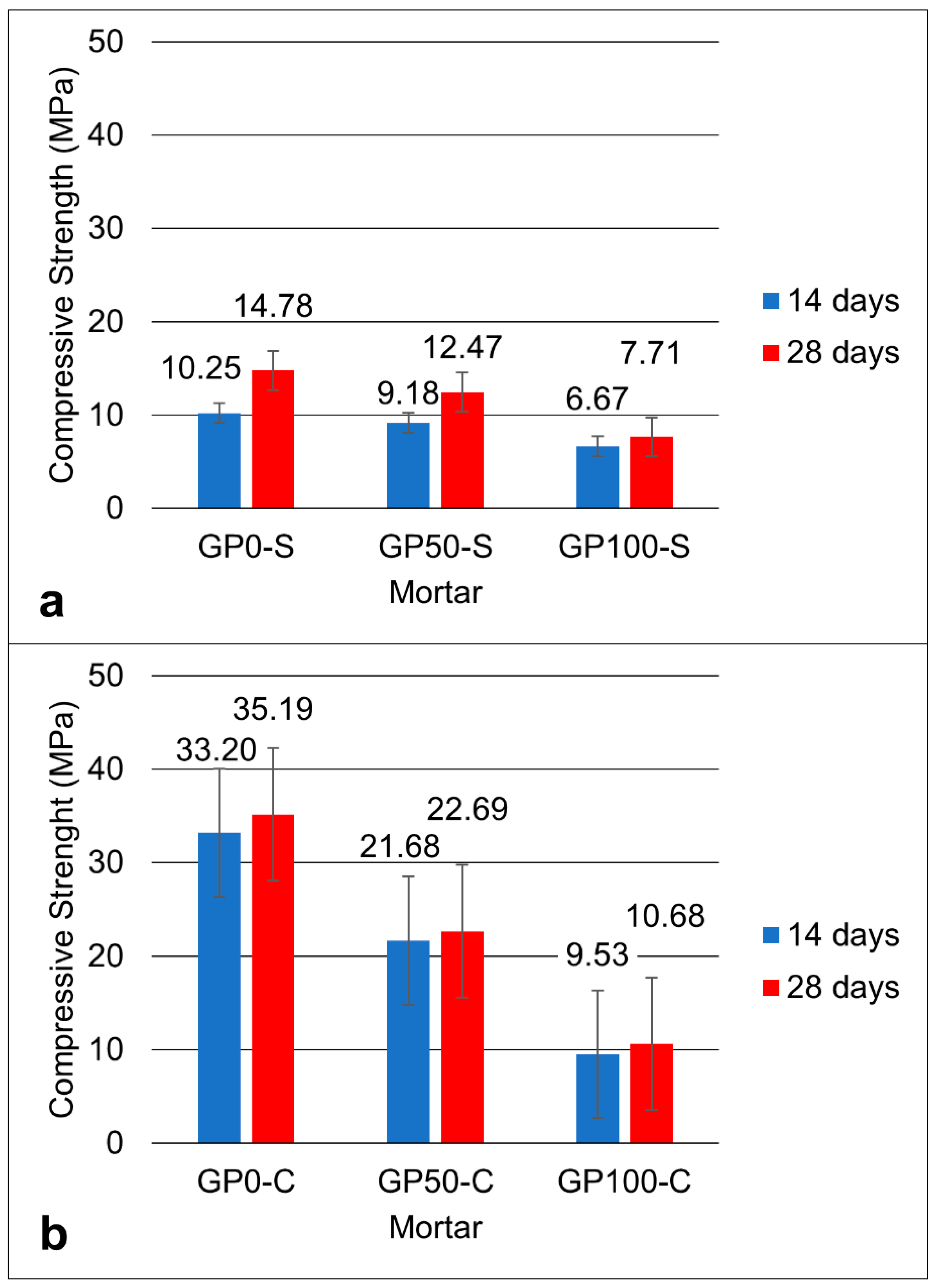
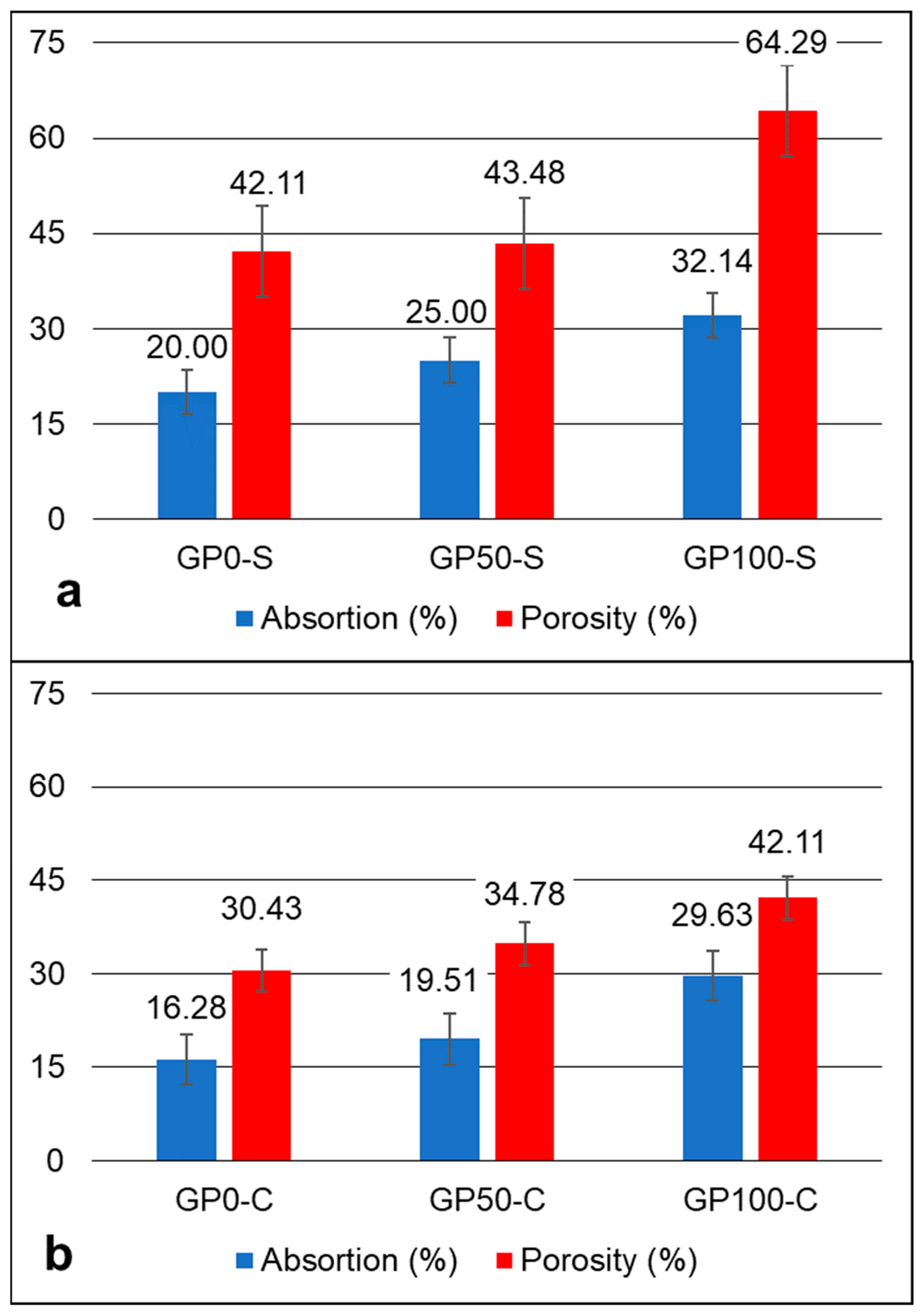

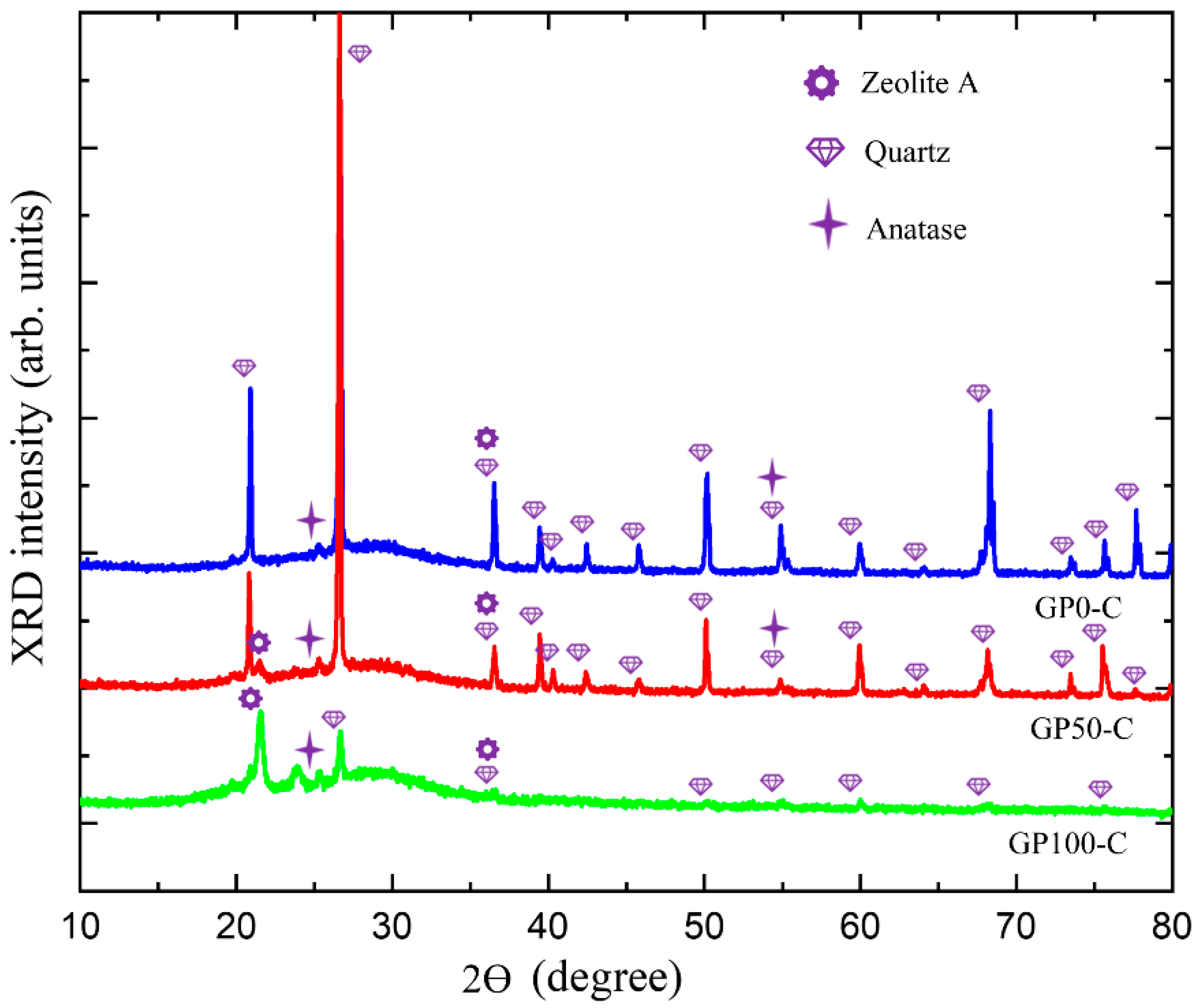
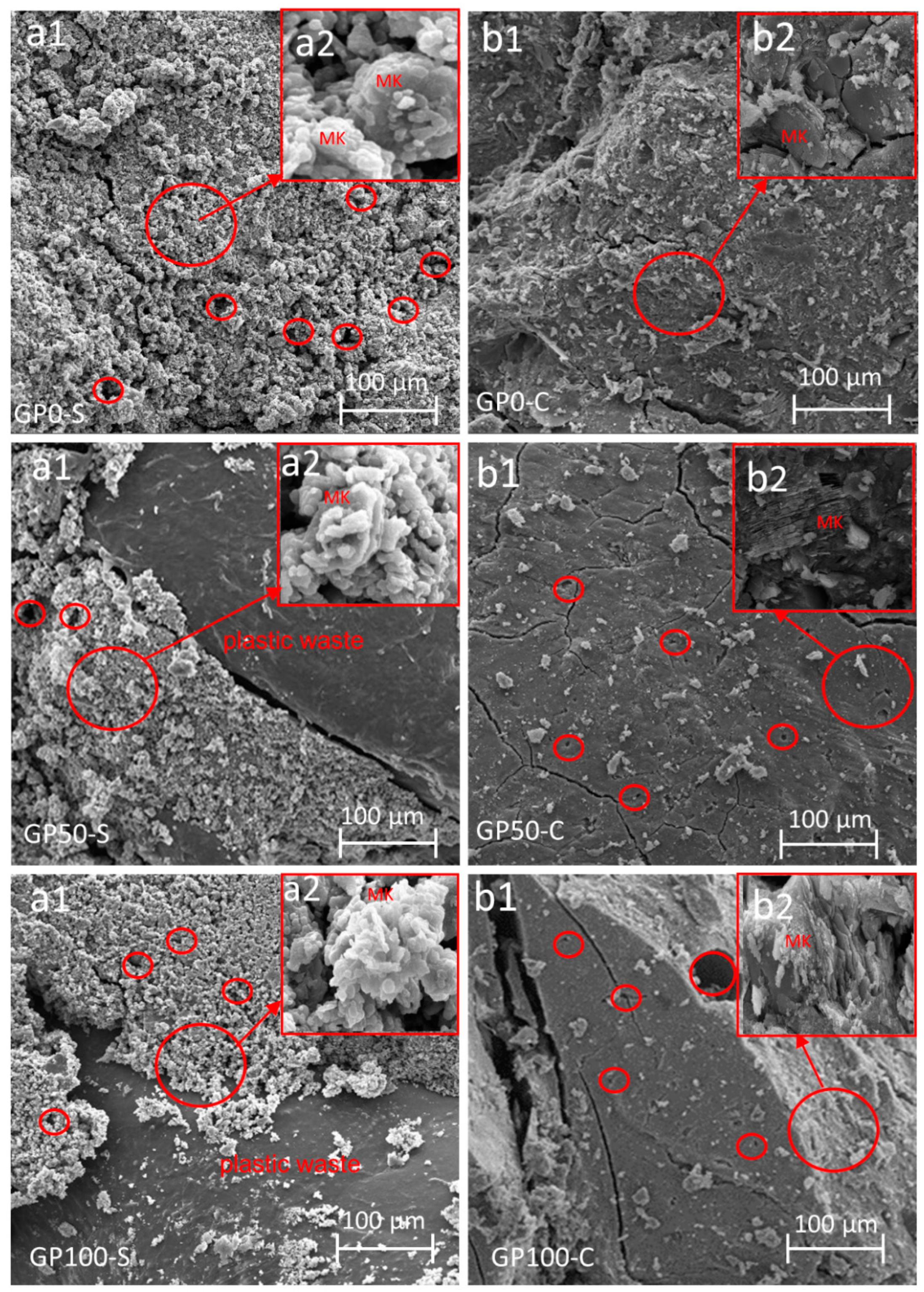


| Samples | Metakaolinite (g) | Plastic Waste (g) | Sand (g) | NaOH (g) | Na2SiO3 (g) |
|---|---|---|---|---|---|
| GP0-S | 100 | 0 | 100 | 80 | 0 |
| GP50-S | 100 | 18.4 | 50 | 80 | 0 |
| GP100-S | 100 | 36.9 | 0 | 80 | 0 |
| GP0-C | 100 | 0 | 100 | 40 | 50 |
| GP50-C | 100 | 18.4 | 50 | 40 | 50 |
| GP100-C | 100 | 36.9 | 0 | 40 | 50 |
| Oxide | SiO2 | Al2O3 | P2O5 | K2O | CaO | TiO2 | ZnO | Ag | Fe2O3 | Others |
|---|---|---|---|---|---|---|---|---|---|---|
| Metakaolinite | 51.55 | 40.66 | <0.05 | 0.33 | <0.01 | 1.14 | 0 | 0 | 0.89 | 0.50 |
| Sand | 96.40 | 1.07 | 0.93 | 0.60 | 0.44 | 0.13 | 0 | 0 | 0.21 | 0.23 |
| Plastic waste | 27.64 | 0 | 36.36 | 0 | 16.48 | 11.17 | 1.89 | 3.46 | 2.51 | 0.49 |
| Material | Density (g/cm3) | Surface Area (m2/g) | d10 (µm) | d50 (µm) | d60 (µm) | d90 (µm) |
|---|---|---|---|---|---|---|
| Metakaolinite | 2.68 | 1.38 | 1.86 | 7.65 | 10.57 | 44.69 |
| Sand | 2.60 | 0.041 | 81.77 | 244.56 | 282.73 | 464.13 |
| Plastic waste | 0.94 | 0.016 | 241.31 | 480.30 | 532.35 | 773.82 |
Publisher’s Note: MDPI stays neutral with regard to jurisdictional claims in published maps and institutional affiliations. |
© 2022 by the authors. Licensee MDPI, Basel, Switzerland. This article is an open access article distributed under the terms and conditions of the Creative Commons Attribution (CC BY) license (https://creativecommons.org/licenses/by/4.0/).
Share and Cite
Soares, I.; Nobre, F.X.; Vasconcelos, R.; Ramírez, M.A. Study of Metakaolinite Geopolymeric Mortar with Plastic Waste Replacing the Sand: Effects on the Mechanical Properties, Microstructure, and Efflorescence. Materials 2022, 15, 8626. https://doi.org/10.3390/ma15238626
Soares I, Nobre FX, Vasconcelos R, Ramírez MA. Study of Metakaolinite Geopolymeric Mortar with Plastic Waste Replacing the Sand: Effects on the Mechanical Properties, Microstructure, and Efflorescence. Materials. 2022; 15(23):8626. https://doi.org/10.3390/ma15238626
Chicago/Turabian StyleSoares, Ivana, Francisco X. Nobre, Raimundo Vasconcelos, and Miguel A. Ramírez. 2022. "Study of Metakaolinite Geopolymeric Mortar with Plastic Waste Replacing the Sand: Effects on the Mechanical Properties, Microstructure, and Efflorescence" Materials 15, no. 23: 8626. https://doi.org/10.3390/ma15238626
APA StyleSoares, I., Nobre, F. X., Vasconcelos, R., & Ramírez, M. A. (2022). Study of Metakaolinite Geopolymeric Mortar with Plastic Waste Replacing the Sand: Effects on the Mechanical Properties, Microstructure, and Efflorescence. Materials, 15(23), 8626. https://doi.org/10.3390/ma15238626








